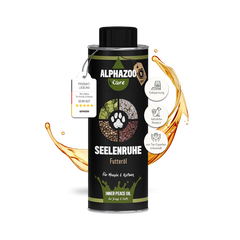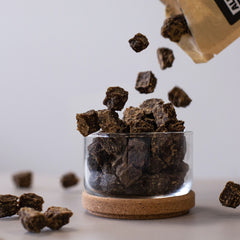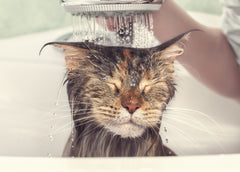Bathing cats: sensible care or unnecessary stress?
Cats and water – for most house cats, these two don't mix. While cats usually clean themselves adequately, there are situations where a bath seems unavoidable. But how do you bathe a cat without causing stress for both of you? In this blog, we'll explain when cats should be bathed, which products you can use, and how to make the bath as pleasant as possible.
Should you bathe cats at all?
Most cats are true masters of grooming and rarely need additional assistance. Their rough tongue coating effectively removes dirt and loose hair. But there are exceptions.
When is bathing necessary?
- Heavy dirt: If your cat has gotten into something unhealthy or sticky.
- Parasites: A special shampoo can help with flea infestation.
- Skin problems: Medicated shampoos may be necessary for skin conditions.
- Older or sick cats: They are sometimes no longer able to groom themselves sufficiently.
When should you avoid bathing?
- If your cat is anxious and stress is overwhelming.
- If there are no health or hygiene reasons.
How often should you bathe cats?
Cats should only be bathed in exceptional circumstances. A bath every few months, or as needed, is perfectly sufficient.
Why not more often?
- Cat skin is sensitive, and frequent bathing can remove the skin's natural oils.
- Bathing too often can dry out the skin and cause itching.
The right shampoo for cats
Not every shampoo is suitable for cats. Human products or even dog shampoos can contain ingredients that are harmful to cats.
Which shampoo is suitable?
- Special cat shampoo: Developed for the needs of cat skin.
- Medicated shampoo: Recommended by the veterinarian for skin problems or parasites.
- Natural shampoos: No artificial fragrances or harsh chemicals.
Stay away from:
- Shampoos containing essential oils (e.g. tea tree oil, which can be toxic).
- Human shampoos or soaps.
Preparation: Everything you need to know before bathing your cat
Bathing a cat requires planning to make the process as stress-free as possible for both of you.
1. Prepare the environment
- Close doors and windows to avoid drafts.
- Place non-slip mats in the tub or sink.
- Have all the necessary utensils ready: shampoo, towels, brush.
2. Prepare water
- Lukewarm water is ideal (approx. 37 °C).
- Fill the tub or sink only a few centimeters high.
3. Prepare the cat
- Brush the coat before bathing to remove matting.
- Trim long claws to avoid scratches.
Step-by-step instructions: How to bathe your cat
The bath itself should be carried out quickly but carefully. Follow these steps:
1. Calm introduction
- Speak soothingly to your cat and slowly place it in the water.
- Hold her gently but securely.
2. Soak
- Carefully pour water over the fur, avoiding the face and ears.
3. Apply shampoo
- Distribute the shampoo evenly and massage it in gently.
- Make sure to rinse the shampoo out thoroughly.
4. Cleanse your face
- Use a damp cloth to gently cleanse your face.
5. Dry off
- Wrap your cat in a towel and pat it dry.
- Avoid loud hair dryers unless your cat tolerates them.
How do you reduce stress while bathing?
Many cats find bathing stressful. With the right tips, you can ease the situation.
Tips for reducing stress:
- Play beforehand: A tired cat is calmer.
- Provide treats: Reward your cat during and after the bath.
- Act quickly: Keep the bath as short as possible.
- Partner assistance: A second person can help with holding and calming.
Alternatives to bathing
If bathing is too stressful for your cat, there are alternatives:
1. Wet wipes
- Special pet wipes are ideal for minor cleaning.
2. Dry shampoos
- Powders or foams that are massaged into the coat and brushed out.
3. Brushing
- Regular brushing removes loose hair and surface dirt.
Frequently asked questions about bathing cats
“Is it okay to bathe cats?”
Yes, but only in exceptional cases and with the right shampoo.
“Can I bathe my cat with regular shampoo?”
No, only use cat shampoo, as human products can irritate the skin.
“How do I keep my cat calm while bathing?”
Speak to her soothingly, work quickly and reward her with treats.
“How do I dry my cat after bathing?”
Pat the fur dry with a towel. Avoid using a hair dryer unless your cat is used to it.
Conclusion: Bathing cats – only when it is really necessary
Bathing cats should always be the exception. The most important points at a glance:
- When should you bathe? Only in cases of heavy dirt, parasites, or for health reasons.
- Shampoo: Use special cat shampoo.
- Avoid stress: Good preparation and a calm approach are crucial.
- Alternatives: Wet wipes and dry shampoos can help avoid a full bath.
With these tips, you can ensure that bathing your cat is as stress-free as possible – and that you can quickly cuddle up on the couch again!

















